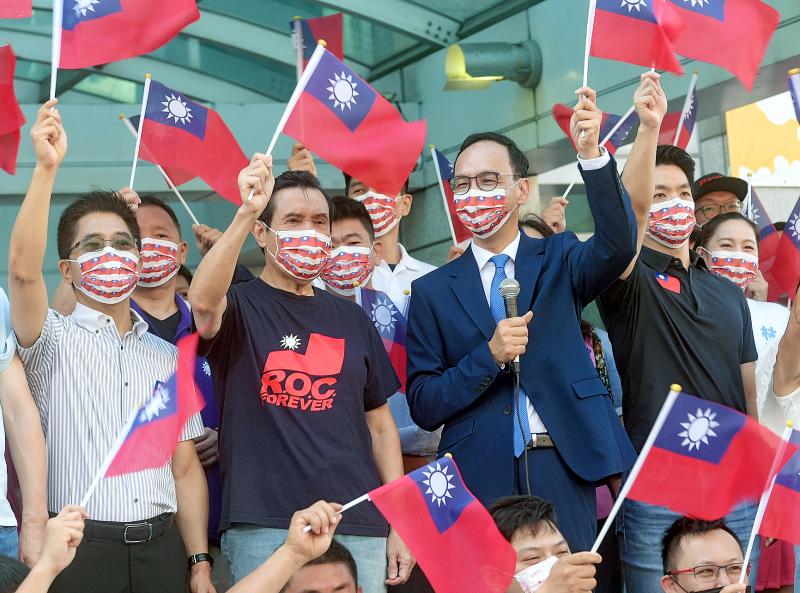The two sides of the Taiwan Strait in their interactions should respect Sun Yat-sen’s (孫逸仙) founding of the Republic of China (ROC) 110 [sic] years ago, Chinese Nationalist Party (KMT) Chairman Eric Chu (朱立倫) said yesterday.
Chu made the remarks at a flag-raising ceremony at the KMT headquarters in Taipei to mark Double Ten National Day.
Over the past 110 years, the ROC has remained unshakable in the midst of turmoil, said Chu, who assumed the role of KMT chairman on Tuesday last week.

Photo: Chang Chia-ming, Taipei Times
“From establishing the Republic of China to defending Taiwan and building Taiwan, the KMT has always stood at the forefront of the people and worked hard for this land,” he said. “We are the political party that loves the Republic of China and Taiwan the most.”
“We will always be believers” of Sun, he said, adding that whether in Taiwan, at home or abroad, all Sun’s believers “must defend the Republic of China, safeguard our freedom and democracy, and firmly guard the peace and prosperity that all our people expect.”
“Both sides of the Strait should uphold this spirit,” he said, adding that the basis of cross-strait relations was seeking common ground while retaining differences of opinion.
It is essential to respect that Sun founded the ROC 110 years ago, he said.
While the ROC was founded on Jan. 1, 1912, it was preceded by the Wuchang Uprising of Oct. 10, 1911.
A responsible ruling party should respect public opinion and defend the ROC, he said.
“Do not distort the history of the Republic of China,” or undermine the efforts past presidents and KMT members, he said.
The ROC is the name of the nation in the Constitution, former president Ma Ying-jeou (馬英九) said at the event.
Since President Tsai Ing-wen (蔡英文) took office five years ago, the “lead role” — the ROC — seems to have taken a “supporting role” in Double Ten National Day celebrations, he said.
Tsai should apologize for the “disappearance” of the Republic of China, he added.
Ma said that the Chinese Communist Party’s separate references to the “1992 consensus” and its “one China principle” over the past six months is an “important message,” as it implies the two statements are not the same.
This indicates that there is space for each side to seek common ground while maintaining differences of opinion, Ma said.
“I have repeatedly said that the ‘1992 consensus’ and ‘one China interpretations are crucial in maintaining cross-strait peace and prosperity,” Ma said.
The “1992 consensus” — a term that former Mainland Affairs Council chairman Su Chi (蘇起) in 2006 admitted making up in 2000 — refers to a tacit understanding between the KMT and the Chinese Communist Party.
Additional reporting by CNA

An essay competition jointly organized by a local writing society and a publisher affiliated with the Chinese Communist Party (CCP) might have contravened the Act Governing Relations Between the People of the Taiwan Area and the Mainland Area (臺灣地區與大陸地區人民關係條例), the Mainland Affairs Council (MAC) said on Thursday. “In this case, the partner organization is clearly an agency under the CCP’s Fujian Provincial Committee,” MAC Deputy Minister and spokesperson Liang Wen-chieh (梁文傑) said at a news briefing in Taipei. “It also involves bringing Taiwanese students to China with all-expenses-paid arrangements to attend award ceremonies and camps,” Liang said. Those two “characteristics” are typically sufficient

A magnitude 5.9 earthquake that struck about 33km off the coast of Hualien City was the "main shock" in a series of quakes in the area, with aftershocks expected over the next three days, the Central Weather Administration (CWA) said yesterday. Prior to the magnitude 5.9 quake shaking most of Taiwan at 6:53pm yesterday, six other earthquakes stronger than a magnitude of 4, starting with a magnitude 5.5 quake at 6:09pm, occurred in the area. CWA Seismological Center Director Wu Chien-fu (吳健富) confirmed that the quakes were all part of the same series and that the magnitude 5.5 temblor was

The brilliant blue waters, thick foliage and bucolic atmosphere on this seemingly idyllic archipelago deep in the Pacific Ocean belie the key role it now plays in a titanic geopolitical struggle. Palau is again on the front line as China, and the US and its allies prepare their forces in an intensifying contest for control over the Asia-Pacific region. The democratic nation of just 17,000 people hosts US-controlled airstrips and soon-to-be-completed radar installations that the US military describes as “critical” to monitoring vast swathes of water and airspace. It is also a key piece of the second island chain, a string of

The Central Weather Administration has issued a heat alert for southeastern Taiwan, warning of temperatures as high as 36°C today, while alerting some coastal areas of strong winds later in the day. Kaohsiung’s Neimen District (內門) and Pingtung County’s Neipu Township (內埔) are under an orange heat alert, which warns of temperatures as high as 36°C for three consecutive days, the CWA said, citing southwest winds. The heat would also extend to Tainan’s Nansi (楠西) and Yujing (玉井) districts, as well as Pingtung’s Gaoshu (高樹), Yanpu (鹽埔) and Majia (瑪家) townships, it said, forecasting highs of up to 36°C in those areas